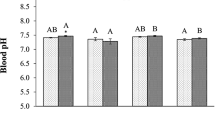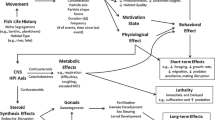Abstract
Juvenile Atlantic cod, Gadus morhua, that had been fed rotifers as larvae (R group) had significantly lower growth rates (SGR) at high-ambient ammonia (UIA = 115–120 μg l−1) than did juveniles that had been first fed with natural zooplankton (Z group). Overall specific growth rates (SGRs) were 5–11% higher in the Z group at the control ammonia (UIA = 1–2 μg l−1) treatments. An interaction between larval rearing history, oxygen and ammonia levels was found, as SGR decreased with decreasing oxygen levels at high ammonia in the R group, while the SGR in the Z group were less affected by hypoxia. At high-ambient ammonia, the SGRs were 5% (mild hyperoxia, 101–104% O2 in effluent water), 28% (normoxia, 83–88% O2 in effluent water) and 86% (hypoxia, 57–69% O2 in effluent water) higher in the Z group, compared to the R group. The present findings indicate that larval rearing environment could influence the adaptability to environmental changes and growth performance during later juvenile stage in cod. These findings have implications for the optimization of Atlantic cod culture.



Similar content being viewed by others
References
Amberg JJ, Myr C, Kamisaka Y, Jordal AEO, Rust MB, Hardy RW, Koedijk R, Rønnestad I (2008) Expression of the oligopeptide transporter, PepT1, in larval Atlantic cod (Gadus morhua). Comp Biochem Physiol 150B:177–182
Bell JG, McEvoy LA, Estevez A, Shields RJ, Sargent JR (2003) Optimising lipid nutrition in first-feeding flatfish larvae. Aquaculture 227:211–220
Brown MB, Forsythe AB (1974) Robust tests for the equality of variances. J Am Stat Assoc 69:364–367
Conceição LEC, van der Meeren T, Verreth JAJ, Evjen MS, Houlihan DF, Fyhn HJ (1997) Amino acid metabolism and protein turnover in larval turbot (Scophthalmus maximus) fed natural zooplankton or Artemia. Mar Biol 129:255–265
Drillet G, Jørgensen NOG, Sørensen TF, Ramlov H, Hansen BW (2006) Biochemical and technical observations supporting the use of copepods as live feed organisms in marine larviculture. Aquac Res 37:756–772
Estevez A, Ishikawa M, Kanazawa A (1997) Effects of arachidonic acid on pigmentation and fatty acid composition of Japanese flounder, Paralichthys olivaceus (Temminck and Schlegel). Aquac Res 28:279–289
Evjemo JO, Reitan KI, Olsen Y (2003) Copepods as live food organisms in the larval rearing of halibut larvae (Hippoglossus hippoglossus L.) with special emphasis on the nutritional value. Aquaculture 227:191–210
Foss A, Vollen T, Øiestad V (2003) Growth and oxygen consumption in normal and O2 supersaturated water, and interactive effects of O2 saturation and ammonia on growth in spotted wolffish (Anarhichas minor Olafsen). Aquaculture 224:105–116
Foss A, Siikavuopio SI, Sæther BS, Evensen TH (2004) Effect of chronic ammonia exposure on growth in juvenile Atlantic cod. Aquaculture 237:179–189
Garcia AS, Parrish CC, Brown JA (2008) Use of enriched rotifers and Artemia during larviculture of Atlantic cod (Gadus morhua Linnaeus, 1758): effects on early growth, survival and lipid composition. Aquac Res 39:406–419
Hamre K, Opstad I, Espe M, Solbakken J, Hemre GI, Pittman K (2002) Nutrient composition and metamorphosis success of Atlantic halibut (Hippoglossus hippoglossus, L.) larvae fed natural zooplankton or Artemia. Aquac Nutr 8:139–148
Hamre K, Holen E, Moren M (2007) Pigmentation and eye migration in Atlantic halibut (Hippoglossus hippoglossus L.) larvae: new findings and hypotheses. Aquac Nutr 13:65–80
Houde ED, Schekter RC (1981) Growth rates, rations and cohort consumption of marine fish larvae in relation to prey concentrations. Rapp Proc-verb Réun Con inter l’Explor Mer 178:441–453
Imsland AK, Foss A, Koedijk R, Folkvord A, Stefansson SO, Jonassen TM (2006) Short and long term differences in growth, feed conversion efficiency and deformities of juvenile Atlantic cod (Gadus morhua) startfed on rotifers or zooplankton. Aquac Res 37:1015–1027
Imsland AK, Koedijk R, Foss A, Hjörleifsdóttir S, Hreggviðsson GÓ, Otterlei E, Stefansson SO, Folkvord A (2011) A retrospective approach to fractionize variation in body mass of Atlantic cod Gadus morhua. J Fish Biol 78:251–264
Jobling M (1994) Fish bioenergetics. Chapman and Hall, London
Johnson RA, Wichern DW (1992) Applied multivariate statistical analysis. Prentice-Hall, Englewood Cliffs
Kjesbu OS, Solemdal P, Bratland P, Fonn M (1996) Variation in annual egg production in individual captive Atlantic cod (Gadus morhua). Can J Fish Aquat Sci 53:610–620
Koedijk R, Le François NR, Blier PU, Foss A, Folkvord A, Ditlecadet D, Lamarre SG, Stefansson SO, Imsland AK (2010a) Ontogenetic effects of diet during early development on growth performance, myosin mRNA expression and metabolic enzyme activity in Atlantic cod juveniles reared at different salinities. Comp Biochem Physiol 156A:102–109
Koedijk R, Folkvord A, Foss A, Pittman K, Stefansson SO, Handeland S, Imsland AK (2010b) The influence of first-feeding diet on the Atlantic cod Gadus morhua phenotype: survival, development and long-term consequences for growth. J Fish Biol 77:1–19
Koven W (2003) Key factors influencing juvenile quality in mariculture: a review. Isr J Aquac 55:283–297
McEvoy LA, Næss T, Bell JG, Lie Ø (1998) Lipid and fatty acid composition of normal and malpigmented Atlantic halibut (Hippoglossus hippoglossus) fed enriched Artemia: a comparison with fry fed wild copepods. Aquaculture 163:237–250
Næss T, Lie Ø (1998) A sensitive period during first feeding for the determination of pigmentation pattern in Atlantic halibut, Hippoglossus hippoglossus L., juveniles: the role of diet. Aquac Res 29:925–934
Park HG, Puvanendran V, Kellett A, Parrish CC, Brown JA (2006) Effect of enriched rotifers on growth, survival, and composition of larval Atlantic cod (Gadus morhua). ICES J Mar Sci 63:285–295
Person-Le Ruyet J, Pichavant K, Vacher C, Le Bayon N, Severe A, Boeuf G (2002) Effects of O2 supersaturation on metabolism and growth in juvenile turbot (Scophthalmus maximus L.). Aquaculture 205:373–383
Remen M, Imsland AK, Stefansson SO, Jonassen TM, Foss A (2008) Interactive effects of ammonia and oxygen on growth and physiological status of juvenile Atlantic cod (Gadus morhua). Aquaculture 274:292–299
Shields RJ, Bell JG, Luizi FS, Gara B, Bromage NR, Sargent JR (1999) Natural copepods are superior to enriched Artemia as feed for halibut larvae (Hippoglossus hippoglossus) in terms of survival, pigmentation and retinal morphology: relation to dietary essential fatty acids. J Nutr 129:1186–1194
Thorarensen H, Gústavsson A, Mallya Y, Gunnarsson S, Árnason J, Arnarson I, Jónsson AF, Smáradóttir H, Zoega GT, Imsland AK (2010) The effect of oxygen saturation on the growth and feed conversion of Atlantic halibut (Hippoglossus hippoglossus L.). Aquaculture 309:96–102
van der Meeren T, Olsen RE, Hamre K, Fyhn HJ (2008) Biochemical composition of copepods for evaluation of feed quality in production of juvenile marine fish. Aquaculture 274:375–397
Zar JH (1996) Biostatistical analysis, 3rd edn. Prentice-Hall, New Jersey
Acknowledgments
This study was financed by the Norwegian Research Council (No. 156204/120). The authors like to thank Mette Remen for her valuable technical assistance during the experimental period.
Author information
Authors and Affiliations
Corresponding author
Additional information
Koedijk and Imsland have contributed equally.
Rights and permissions
About this article
Cite this article
Koedijk, R., Imsland, A.K., Folkvord, A. et al. Larval rearing environment influences the physiological adaptation in juvenile Atlantic cod, Gadus morhua . Aquacult Int 20, 467–479 (2012). https://doi.org/10.1007/s10499-011-9478-0
Received:
Accepted:
Published:
Issue Date:
DOI: https://doi.org/10.1007/s10499-011-9478-0




